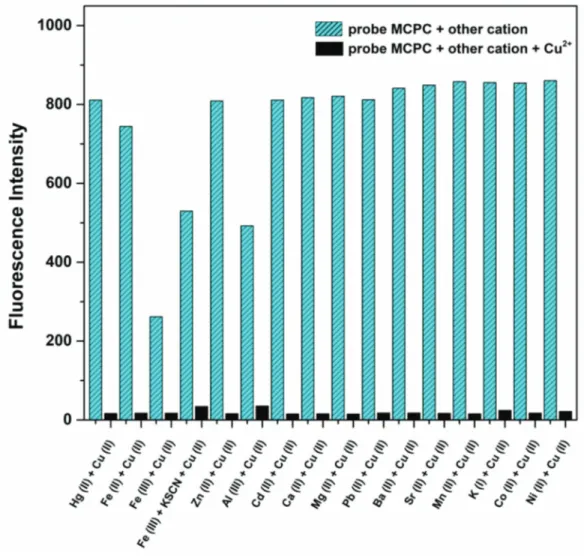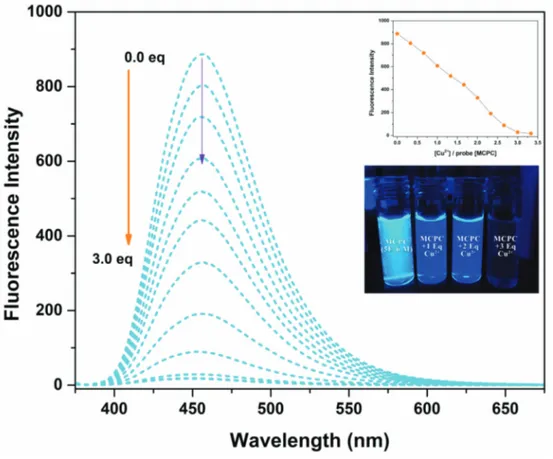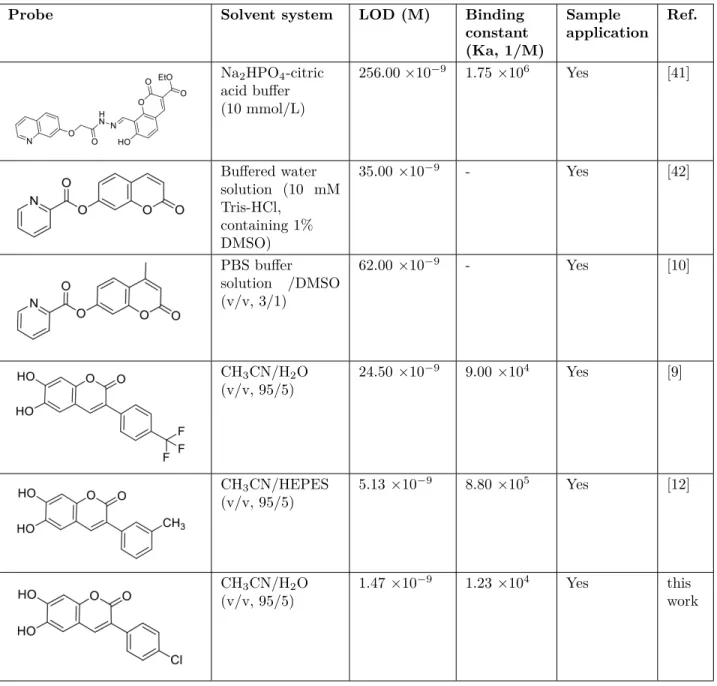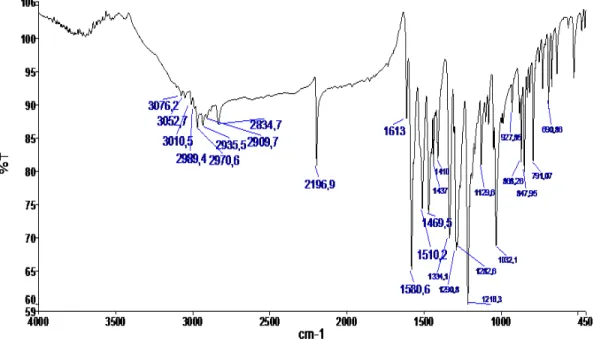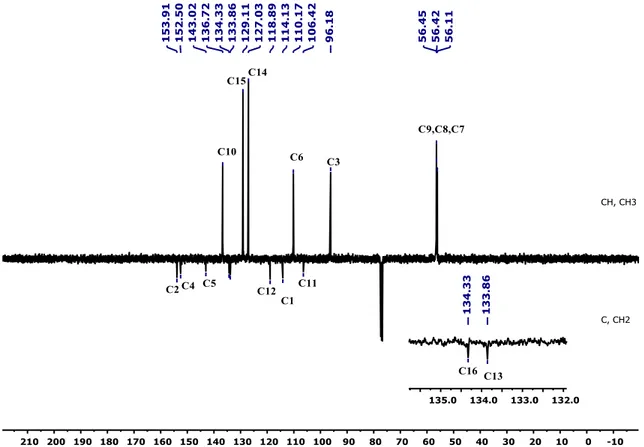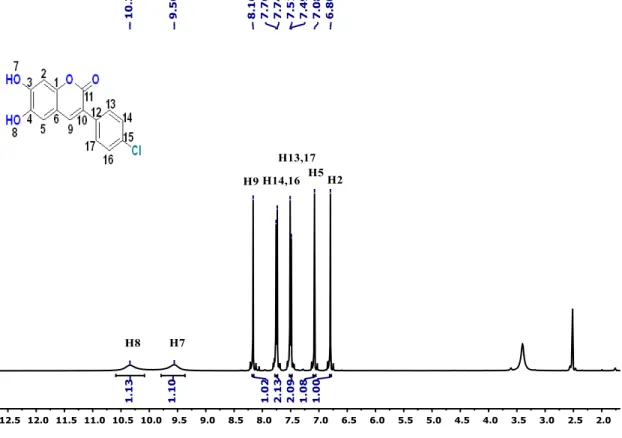Tahir SAVRAN1, Abdurrahman KARAGÖZ1, Şükriye Nihan KARUK ELMAS1,
Duygu AYDIN1, Furkan ÖZEN2, Kenan KORAN3, Fatma Nur ARSLAN1,
Ahmet Orhan GÖRGÜLÜ3, İbrahim YILMAZ1,∗
1Department of Chemistry, Kamil Özdağ Science Faculty, Karamanoğlu Mehmetbey University, Karaman, Turkey 2Department of Mathematics and Science, Faculty of Education, Akdeniz University, Antalya, Turkey
3Department of Chemistry, Faculty of Science, Fırat University, Elazığ, Turkey
Received: 22.04.2020 • Accepted/Published Online: 26.06.2020 • Final Version: 18.08.2020
Abstract: A fluorogenic probe based on a coumarin-derivative for Cu2+ sensing in CH
3CN/H2O media (v/v, 95/5, 5.0
µM) was developed and applied in real samples. 3-(4-chlorophenyl)-6,7-dihydroxy-coumarin (MCPC) probe was obtained by synthetic methodologies and identified by spectral techniques. The probe MCPC showed remarkable changes with a “turn-off” fluorogenic sensing approach for the monitoring of Cu2+ at 456 nm under an excitation wavelength of 366 nm.
The response time of the probe MCPC was founded as only 1 min. The detection limit of the probe MCPC was recorded to be 1.47 nM. The binding constant and possible stoichiometric ratio (1:1) values were determined by Benesi-Hildebrand and Job’s plot systems, respectively. The mechanism of the probe MCPC with Cu2+ was further confirmed by ESI-MS
and FT-IR analyses, as well as supported by theoretical calculations. Furthermore, the probe MCPC was successfully employed for the practical applications to sense Cu2+ in different herbal and black tea samples. The proposed sensing
method was also verified by ICP-OES method.
Key words: Coumarin, fluorescent sensor, copper, DFT, tea samples
1. Introduction
The rapid industrialization has caused heavy metal pollution which is gradually becoming a critical issue over the past three decades. This pollution is considered as a major threat, because heavy metal ions lead to serious problems for the ecological environment and human health [1]. Among the commonly encountered heavy metals
of concern, the Cu2+ is the third most plentiful trace cation in the clay as well as in numerous livings, and it acts
an essential role in numerous biological reactions. Cu2+ acts a vital role in the connective tissue growth, bone
and blood formation as one of the physiological processes of organisms [2], it is also placed in the cornea and
mostly in the brain [3]. However, it has been reported that excess intake of Cu2+ causes adverse health effects in
the body such as gastrointestinal diseases and it damages the kidneys and liver [1,4]. Also, Cu2+ catalyzes the
creation of reactive oxygen species which can harm basic biological molecules. According to various literatures,
the toxicity of Cu2+has linked to severe neurological diseases [5], Indian childhood cirrhosis (ICC) and prion
diseases [2,4,6,7]. World Health Organization (WHO) has reported that the optimum intake of Cu2+ for adults
∗Correspondence: iyilmaz@kmu.edu.tr
should not go above the level of 10–12 mg.day−1 [8]. For this reason, the monitoring of Cu2+ in a variety of
drinking and food samples has been a vital issue for the protection of human health [7]. Thus, the development
of reliable analytical procedures for Cu2+ sensing is still a critical research topic [9].
The reported methods for monitoring Cu2+ include inductively coupled mass-atomic emission
spec-trometry (ICM-AES), capillary electrophoresis (CE), atomic absorption specspec-trometry (AAS), voltammetry and inductively coupled plasma-mass spectrometry (ICP-MS) [10]. These techniques involve expensive analysis sys-tems, troublous analysis procedures, and also need excessive use of samples [11]. In contrast, the fluorescence
spectroscopy is currently taken into account as a powerful method for the recognition of Cu2+ owing to its real
time, low cost, rapid and non destructive sensing with high selectivity and sensitivity [12] and easy operation.
Recently, many fluorescent chemosensor studies for the recognition of Cu2+have been reported [5,13,14]. To
this end, various fluorescent probes based on rhodamine [15], naphthalene [16], BODIPY [17], fluorescein [18], N-aminophthalimide [19], thiophene [20], indole [21], pyrene [22], carbazole [23], cyanine [24] and coumarin [15]
derivatives have employed to determine Cu2+ in several samples. Among these derivatives, coumarin-based
molecules are powerful and highly adjustable fluorescent platforms for the selective and precise measurements
of Cu2+ in drinking water, food and beverage samples [12].
Herein, a “turn-off” fluorogenic probe based on a coumarin-derivative,
3-(4-chlorophenyl)-6,7-dihydroxy-coumarin, probe MCPC, for Cu2+ sensing in CH
3CN/H2O media (v/v, 95/5, 5.0 µM) was prepared and
employed to various herbal and black tea samples. Coumarin compounds have been commonly used to be a florescent sensor thanks to its moderately high water solubility, high fluorescence quantum ( Φ) yield and chemical stability, and also its large Stoke’s shift. In addition, coumarin derivatives are less toxic to the livings and eco-friendly compounds [9]. The synthesized probe MPCP was successfully identified by spectral techniques
such as 1H-NMR and 13C-ATP-NMR, as well as FT-IR. The theoretical computations were also done for the
optimized geometric features. 2. Materials and methods
2.1. Chemicals and instrumentation
All chemicals used herein were of spectroscopic grade and obtained from Merck KGaA (Darmstadt, Ger-many) and VWR International B.V. (Amsterdam, Netherlands). Ultrapure water was acquired from Milli-Q ® 7003/05/10/15 machine (Water purification system, Merck KGaA, Darmstadt, Germany). Solutions of
different metal ions (Hg2+, K+, Mn2+, Cu2+, Ba2+, Cd2+, Co2+, Ca2+, Zn2+, Mg2+, Na+, Fe2+, Sr2+,
Pb2+, Fe3+ and Al3+) (10 mM, perchlorate salts in acetonitrile) were prepared as a stock solution.
A Bruker DPX 400 MHz spectrometer (Bruker Corp., Billerica, MA, USA) was employed to measure
13C-APT-NMR and1H-NMR spectra. A Mass spectrometer (Bruker Daltonics-MicroflexT M, Bruker Corp.)
was used to record electro spray ionization-mass spectra (ESI-MS). Infrared spectra were taken on a FT-IR spectrometer (Spectrum 100, Perkin Elmer Inc., Wellesley, MA, USA). A fluorescence spectrophotometer (Cary Eclipse, Agilent Tech., Santa Clara, CA, USA) was employed to record fluorescence spectra at rt. As a reference
method, the amount of Cu2+ in herbal tea samples was analyzed by an inductively coupled plasma-optical
emission spectroscopy (ICP-OES) (720, Agilent Tech.). For the pH measurements and centrifugation procedures, a pH meter (Mettler Toledo, Zaventem, Netherlands) and Universal 320R centrifuge system (Andreas Hettich GmbH & Co. KG, Tuttlingen, Germany) were used, respectively.
concentration with the mixture of CH3CN/H2O (v/v, 95/5). The titration experiments were performed to
achieve the relationship between emission intensities and Cu2+. For the fluorescence titration experiments, the
different amounts of the cations (0–3.0 equiv) were added to 3000 µL of the probe solution. Spectra were taken
at room temperature and recorded at λem = 456 nm ( λex = 366 nm, 5 nm slit width).
The LOD of the probe MCPC was calculated from the equation of 3 σ /k (slope value) [28–31]. To
analyze the effect of the possible competing cations on the sensing ability of probe MCPC to Cu2+, suitable
concentration of Cu2+ (3.0 equiv) was added into probe MCPC solution to generate MCPC-Cu2+ complex,
afterwards each of the other cation solutions was added into the MCPC-Cu2+, respectively. The emission
intensities of the MCPC-Cu2+ complex were measured before and after adding other cations. The possible
stoichiometric ratio between the probe MCPC and Cu2+ in MCPC-Cu2+system was found by using Job’s
method calculation [32]. 2.4. Studies based on DFT
Theoretical calculations were performed for the probe MCPC and MCPC-Cu2+ complex by the DFT /
B3LYP/6-31 g (d) method with Gaussian 09 software (Gaussian, Inc., Wallingford, CT, UK) and accompanying graphical interface program GaussView 5.0.8 [33–37]. The LanL2DZ basis set for the effective potential set for Cu, and the 6-311G basis set was used for C, H, O atoms. To obtain the HOMO and LUMO energy levels, DFT analyses were performed based on the optimized geometries.
2.5. Detecting Cu2+in tea samples by fluorometric sensing and ICP-OES
Eleven kinds of herbal tea leaves (green tea, white tea, sage tea, fennel tea, daisy tea, rose hip tea, ginger tea, mint tea, apple tea, linden tea and green tea mixture with rose) and 5 kinds of black tea leaves (black tea samples without aroma and black tea samples with bergamot aroma) were bought from super markets and herbs shops. 2.0 g of each samples were homogenized, individually placed into the boiled ultrapure water (50.0 mL) and infused/waited approximately for 15 min. Prepared tea solutions were placed in a shaker for 20 min, and then they were centrifuged at 10.000 rpm for 5 min. Final solutions were cleaned with a membrane filter
(0.45 µ m pore-size) and then the amounts of Cu2+in teas were identified by the probe MCPC and ICP-OES
systems. For fluorometric sensing analysis, probe MCPC solution was freshly prepared in CH3CN/H2O media
(v/v, 95/5, 5.0 µM). 3000 µL of probe MCPC solution was put into the quartz-cuvette, and then the spectra
were measured at rt ( λex = 366 nm, λem = 456 nm, 5 nm slit width). Then, 15 µ L of each tea samples
individually put into the probe MCPC, and the spectra were recorded by the same procedure. Finally, this
solution (tea sample + probe MCPC) was spiked with 15 µL of diverse amounts of Cu2+ (0.1 and 0.2 µ M)
acidified with HNO3 (v/v, 1%) in the 10 mL of centrifuge tubes. pH value of these solutions were adjusted to 9
with a buffer solution (NH3/NH4Cl), and just after 15 min of waiting time, all teas were centrifuged at 10.000
rpm (~5 min). 0.5 mL of d-HNO3 solution was added to the bottom layer in the tubes and this layer was diluted
to 2500 µL with ultra-pure water. Before ICP-OES analysis, the sample solution was cleaned with a membrane filter (0.45 µ m pore-size) to eliminate possible contaminations. The operating conditions of ICP-OES method were presented in Table S1. The analyses were done in triplicate and outcomes were illustrated as mean ±std. 3. Results and discussion
3.1. Design of the probe MCPC
The probe MCPC was prepared under microwave irradiation with solvent free condition by the reaction of
compound (3) with pyridinium hydrochloride (85% yield) (Scheme 1), and it was well-verified by 1H-NMR,
FT-IR and 13C-ATP-NMR analyses (Figures S1–S6).
Scheme 1. Synthetic scheme of the probe MCPC.
As seen in FT-IR spectrum of the probe MCPC, the peaks appeared at 3197 and 3398 cm−1 were
revealed the presence of -OH and also, -C = O peak in the coumarin ring was appeared at 1660 cm−1(Figure
S4). Moreover, the proton NMR for 2, 5, and 9 protons gives singlet peaks at 6.80, 7.08, and 8.16 ppm, respectively. In addition, protons 13 and 14 give doublet peaks at 7.51 and 7.74 ppm. The -OH proton peaks
are observed at 9.56 and 10.34 ppm belong to H7 and H8. Characteristic functional group conversions show
that the formation of probe MCPC was successfully achieved.
3.2. Fluorogenic response of the probe MCPC towards Cu2+sensing
To study the fluorogenic sensing ability, the response of probe MCPC towards a series of various cations (Hg2+,
Figure 1. (a) Spectra of probe MCPC in the presence of competing ions (3.0 equiv), and (b) fluorescence colors of MCPC in presence of competing cations in CH3CN/H2O media (v/v, 95/5) (5.0 µM) ( λex = 366 nm, λem = 456 nm).
3.2.1. Competitive experiments
To determine the practical efficacy of probe MCPC as a fluorogenic chemosensor for Cu2+ monitoring, the
competitive experiments were performed with various cations (3.0 equiv) (Hg2+, K+, Mn2+, Cu2+, Ba2+,
Cd2+, Co2+, Ca2+, Zn2+, Mg2+, Na+, Fe2+, Sr2+, Pb2+, Fe3+ and Al3+) in CH
3CN/H2O media (v/v,
95/5, 5.0 µM) (Figure 2).
The emission intensity of probe MCPC was quenched with Cu2+ in the presence of other ions and there
was no interference with other cations except Fe3+ (Figure 2). This cation could be easily masked by potassium
thiocyanate (KSCN); hence it has a little impact on the selectivity of probe MCPC toward Cu2+. That is to
say, probe MCPC could be employed as an excellent selective sensor for the monitoring of Cu2+.
3.2.2. Sensivity experiments
Fluorescence titration study was performed to investigate the quantitative interaction features of probe MCPC
Figure 2. Competitive selectivity of probe MCPC (5.0 µ M) toward Cu2+ in the presence of competing ions in
CH3CN/H2O media (v/v, 95/5, 5.0 µM) (3.0 equiv, λex = 366 nm, λem = 456 nm).
decreasement up to the constant equiv value, 3.0 equiv. Due to the complexation reaction between the probe
MCPC and Cu2+, the quenching phenomena could occur via the heavy atom & paramagnetic effect [38] and
CHEQ (chelation enhancement quenching effect) [39] mechanisms. Therefore, the probe MCPC could be used
as an outstanding “turn-off” fluorogenic sensor for Cu2+ monitoring.
3.2.3. Response time experiments
As well, the time dependence of the probe MCPC (5.0 µ M) to Cu2+ (3.0 equiv) was studied (Figure S7) in
CH3CN/H2O media (v/v, 95/5, 5.0 µM) to decide the reaction time for the MCPC-Cu2+. The intensity of
probe MCPC reached a maximum/stabile value within approximately 1 min; hence this result showed that
Figure 3. Spectral changes of probe MCPC upon the adding of Cu2+ (0 to 3.0 equiv) in CH
3CN/H2O media (v/v,
95/5, 5.0 µM) ( λex = 366 nm, λem = 456 nm).
3.2.4. ESI-MS and Job’s plot results
To consider the binding mode/stoichiometry of probe MCPC toward Cu2+, Job’s plot [32] (Figure 4), as well
as ESI-MS analysis recorded in different matrixes and modes (Figures 5a and 5b) were carried out. The results
of these analyses showed the stoichiometric ratio of MCPC-Cu2+ complex as 1:1.
As illustrated in Figure 5, the peaks at 288.00 [m/z], 351.50 [m/z] and 367.50 [m/z] can be attributed
to [probe MCPC], [probe MCPC + Cu2+] and [probe MCPC + Cu2++ H
2O - 2•H+], respectively, which
demonstrated that probe MCPC complexed with Cu2+ in a ratio of 1:1. The content of water in the
MCPC-Cu2+ system can be seen from the ESI-MS, as well from FT-IR spectrum (Figure S8). The complexation
process was recognized between Cu2+ and two protons belong to the hydroxyl groups (Scheme 2).
On the basis of 1:1 stoichiometry, the binding constant of the MCPC-Cu2+ system was computed from
the Benesi-Hildebrand equation [40], and it was found to be 1.23 ×104 M−1, which inferred that the stability of
MCPC-Cu2+ complex was very high (Figure 6a). The calibration curve of the quantitative association between
the intensity and amount of Cu2+ was acquired with an excellent linear range (y = 5.92 ×107x− 905.04, R2 =
0.9957) at nanomolar levels (Figure 6b). The detection limit value of probe MCPC for Cu2+ was calculated
as 1.47 nM (3 σ / slope) [28,29]. The sensing properties of the probe MCPC are comparable to those of other
Figure 4. Job’s plots of MCPC-Cu2+ complex in CH
3CN/H2O media (v/v, 95/5, 5.0 µM) ( λex = 366 nm, λem = 456 nm).
Figure 5. ESI-MS spectra of the probe MCPC and MCPC-Cu2+ system.
compared to our previous coumarin based fluorescent sensor studies [9,12], it is obvious that this study is more sensitive than others in terms of the detection limit value as a result of the substituent effect in the structure. Although the flour atom in the previous study is attached to the benzene ring through an aliphatic carbon, the chlorine in this study is directly connected to the benzene and has greater ability to attract the shared pair of electrons. Therefore, the acidic behaviors of the hydrogen of hydroxyl group increases, since chlorine in benzene ring demonstrates as well as resonance and inductive effect withdraws electrons while the delocalization of lone pair supplies electron density towards the ring. This system enables us the usability of this sensor for sensing
of the toxic Cu2+ at lower concentrations. The electron-donating ability of F
Scheme 2. Possible binding mechanism of the probe MCPC upon adding of Cu2+.
it is found that F3C− <H3C−<Cl− and the abilities are directly proportional to the obtained detection limit
values (24.5 nM <5.13 nM <1.47 nM). As a consequence, the obtained results showed that the probe MCPC
had an excellent sensitivity toward Cu2+ sensing, as well as a good linearity for quantitative detections.
Figure 6. (a) Benesi-Hildebrand curve of 1/[Cu2+] vs 1/(I-I
0) , and (b) the calibration curve of the quantitative
association between the intensities of probe MCPC and the amount of Cu2+ ( λ
ex = 366 nm, λem = 456 nm).
3.3. DFT calculations of the probe MCPC and MCPC-Cu2+complex
To determine the fluorometric sensing mechanism of probe MCPC binding to Cu2+, theoretical computations
were done by using the DFT / B3LYP/6-31 g (d,p) method with Gaussian-09 software package with and accompanying graphical interface program GaussView 5.0.8 [33–37]. The LanL2DZ basis set for the effective potential set for Cu, and the 6-311G basis set was employed for C, H, O atoms (Figure 7). The geometric optimizations were performed in the excited states to obtain the energy minimized structures of probe MCPC
and MCPC-Cu2+ complex. As presented in Figure 7, the energy gap ( ∆ E) of probe MCPC was calculated
Table 1. Relative work of the sensing performance of the probe MCPC with some coumarin-based probe studies.
Probe Solvent system LOD (M) Binding
constant (Ka, 1/M) Sample application Ref. Na2HPO4-citric acid buffer (10 mmol/L) 256.00 ×10−9 1.75 ×106 Yes [41] Buffered water solution (10 mM Tris-HCl, containing 1% DMSO) 35.00 ×10−9 - Yes [42] PBS buffer solution /DMSO (v/v, 3/1) 62.00 ×10−9 - Yes [10] CH3CN/H2O (v/v, 95/5) 24.50 ×10−9 9.00 ×104 Yes [9] CH3CN/HEPES (v/v, 95/5) 5.13 ×10−9 8.80 ×105 Yes [12] CH3CN/H2O (v/v, 95/5) 1.47 ×10−9 1.23 ×104 Yes this work
MCPC-Cu2+ complex was better than probe MCPC based on the theoretical calculations. The increase in the
stability indicates that the route of the reaction tends to the formation of MCPC-Cu2+ complex, and therefore
the fluorescence quenching occurs.
3.4. Fluorometric sensing and ICP-OES analysis of the tea samples
To assess the potential usage of probe MCPC for practical applications, Cu2+ levels were measured in various
herbal tea samples, as well as black tea samples (Table 2). The samples were analyzed by the calibration plot
Figure 7. Energy level diagrams of the MCPC-Cu2+ complex and probe MCPC.
employed by adding two different concentrations (0.1 and 0.2 µ mol L−1) of Cu2+ into the tea samples. As
indicated in Table S2, probe MCPC could be very practical for Cu2+ sensing with satisfactory accuracy and
precision values in tested tea samples. The fluorometric sensing method’s recovery values were calculated within
a range from 90.22% to 109.19%. Thus, Cu2+ can be identified with excellent recovery values in herbal and
T able 2 . Determination of Cu 2+ in herbal and blac k teas b y ICP-OES and prob e MCPC. Cu 2+ (µ mol.L − 1) Difference of the means Statistics (df = 2) MPCP ICP-OES tStatistic probabilit y >|t| Herbal tea samples Green tea 0.1745 ±0.0021 0.1724 ±0.0017 0.0022 2.5476 0.1257 ttabul ated >t cal cul ated Green tea (mixed with rose) 0.0244 ±0.0004 0.0254 ±0.0006 –0.0009 –1.8199 0.2104 White tea 0.1267 ±0.0010 0.1276 ±0.0017 –0.0009 –1.2051 0.3514 Sage tea 0.0689 ±0.0009 0.0682 ±0.0014 0.0006 1.3093 0.3206 F ennel tea 0.0384 ±0.0004 0.0386 ±0.0007 –0.0001 –0.3780 0.7418 Daisy tea 0.0791 ±0.0008 0.0789 ±0.0010 0.0002 2.4277 0.1359 Rose hip tea 0.0664 ±0.0010 0.0662 ±0.0012 0.0003 1.8898 0.1994 Ginger tea 0.0222 ±0.0002 0.0221 ±0.0011 0.0002 0.3111 0.7852 Min t tea 0.0851 ±0.0010 0.0855 ±0.0017 –0.0003 –0.4804 0.6784 Apple tea 0.0104 ±0.0010 0.0102 ±0.0006 0.0002 0.5547 0.6348 Linden tea 0.0880 ±0.0009 0.0876 ±0.0013 0.0004 0.7184 0.5471 Blac k tea samples Blac k tea without aroma-A 0.0843 ±0.0010 0.0845 ±0.0022 –0.0002 –0.2857 0.8019 ttabul ated >t cal cul ated Blac k tea without aroma-B 0.0165 ±0.0002 0.0169 ±0.0006 –0.0004 –1.7320 0.2254 Blac k tea without aroma-C 0.0535 ±0.0004 0.0537 ±0.0013 –0.0002 –0.3255 0.7757 Blac k tea with b ergamot aroma-A 0.1321 ±0.0009 0.1319 ±0.0031 0.0002 0.1644 0.8845 Blac k tea with b ergamot aroma-B 0.0506 ±0.0003 0.0522 ±0.0021 –0.0015 –1.4034 0.2956 †mean(1)-mean(2) = 0 based on Null Hyp o thesis; mean(1)-mean(2) <>0 based on Alternativ e Hyp othesis; the differen tiation of the means is NOT considerably dissimilar with the test v ariation (0) (at the 0 .05 lev el).
Conclusion
As a conclusion, we have developed a low-cost, highly selective and sensitive probe MCPC with quite-low
detection limit for the fluorescent sensing of Cu2+. Probe MCPC demonstrated excellent fluorescence
“turn-off” response to Cu2+ in CH
3CN/H2O media (v/v, 95/5, 5.0 µM) at 456 nm with emission quenching, and it
revealed a rapid response time (∼60 s). The detection limit was found as 1.47 nM according to 3σ /slope, which
indicated excellent sensitivity to Cu2+ sensing in nanomolar levels. The ∆ E values of the probe MCPC and
its complex were calculated to be 3.80 eV and 1.30 eV, respectively. Studies on real samples, herbal and black
teas, revealed that the probe MCPC can sensitively and selectively recognize Cu2+with good recovery values
(90.22%–109.19%). The outcomes of the probe MCPC and ICP-OES analyses were also compared and the differences of the means of two methods were not found significantly different (P <0.05). Thus, these promising
findings could make a great contribution to researchers studying Cu2+detection in different foodstuffs.
Acknowledgment
This work was supported by the Karamanoğlu Mehmetbey University (KMU) with the financial support to use Gaussian-09 and GaussView-5.0.8 software packages (KMU BAP-Grant Number: 30-M-16 and 13-YL-18) and by the Scientific and Technological Research and Council of Turkey (TÜBİITAK) (Grant Number: 110T652).
References
1. Wang S, Ding H, Wang Y, Fan C, Liu G et al. A colorimetric and ratiometric fluorescent sensor for sequentially detecting Cu2+ and arginine based on a coumarin-rhodamine B derivative and its application for bioimaging. RSC
Advances 2019; 9 (12): 6643-6649. doi: 10.1039/c8ra09943j
2. Roy N, Nath S, Dutta A, Mondal P, Paul PC et al. A highly efficient and selective coumarin based fluorescent probe for colorimetric detection of Fe3+ and fluorescence dual sensing of Zn2+ and Cu2+. RSC Advances 2016;
6 (68): 63837-63847. doi: 10.1039/c6ra12217e
3. Bekhradnia A, Domehri E, Khosravi M. Novel coumarin-based fluorescent probe for selective detection of Cu (II). Spectrochimica Acta Part A: Molecular and Biomolecular Spectroscopy 2016; 152 (1): 18-22.
doi: 10.1016/j.saa.2015.07.029
4. Jung HS, Kwon PS, Lee JW, Kim JII, Hong CS et al. Coumarin-derived Cu2+-selective fluorescence sensor:
synthesis, mechanisms, and applications in living cells. Journal of the American Chemical Society 2009; 131 (5): 2008-2012. doi: 10.1021/ja808611d
5. Kim MH, Jang HH, Yi S, Chang SK, Han MS. Coumarin-derivative-based off-on catalytic chemodosimeter for Cu2+ ions. Chemical Communications 2009; 32 (1): 4838-4840. doi: 10.1039/b908638b
6. Shi Y, Wang R, Yuan W, Liu Q, Shi M et al. Easy-to-use colorimetric cyanine probe for the detection of Cu2+ in
Wilson’s disease. ACS Applied Materials & Interfaces, 2018; 10 (24): 20377-20386. doi: 10.1021/acsami.8b07081 7. Yeh JT, Chen WC, Liu SR, Wu SP. A coumarin-based sensitive and selective fluorescent sensor for copper(II)
ions. New Journal of Chemistry 2014; 38 (9): 4434-4439. doi: 10.1039/c4nj00695j
8. Qian B, Váradi L, Trinchi A, Reichman SM, Bao L et al. The Design and synthesis of fluorescent coumarin derivatives and their study for Cu2+ sensing with an application for aqueous soil extracts. Molecules, 2019; 24
(19): 3569. doi: 10.3390/molecules24193569
9. Arslan FN, Geyik GA, Koran K, Ozen F, Aydin D et al. Fluorescence “turn on-off” sensing of copper (II) ions utilizing coumarin-based chemosensor: experimental study, theoretical calculation, mineral and drinking water analysis. Journal of Fluorescence 2020; 30 (1): 317-327. doi: 10.1007/s10895-020-02503-4
10. Wu X, Wang H, Yang S, Tian H, Liu Y et al. A novel coumarin-based fluorescent probe for sensitive detection of copper(II) in wine. Food Chemistry 2019; 284 (1): 23-27. doi: 10.1016/j.foodchem.2019.01.090
11. Yan F, Bai Z, Chen Y, Zu F, Li X et al. Ratiometric fluorescent detection of copper ıons using coumarin-functionalized carbon dots based on FRET. Sensors and Actuators B: Chemical 2018; 275 (1): 86-94. doi: 10.1016/j.snb.2018.08.034
12. Karuk Elmas SN, Gunay IB, Koran K, Ozen F, Aydin D et al. An ultrasensitive and selective “turn off” fluorescent sensor with simple operation for the determination of trace copper (II) ions in water and various beverage samples. Supramolecular Chemistry 2019; 31 (12): 756-766. doi: 10.1080/10610278.2019.1702195
13. Aksuner N, Henden E, Yilmaz I, Cukurovali A. A highly sensitive and selective fluorescent sensor for the determina-tion of copper (II) based on a schiff base. Dyes and Pigments 2009; 83 (2): 211-217. doi: 10.1016/j.dyepig.2009.04.012 14. Aksuner N, Henden E, Yilmaz I, Cukurovali A. Selective optical sensing of copper(II) ions based on a novel cyclobutane-substituted schiff base ligand embedded in polymer films. Sensors and Actuators B: Chemical 2008; 134 (2): 510-515. doi: 10.1016/j.snb.2008.05.041
15. Wang Y, Meng Q, Han Q, He G, Hu Y et al. Selective and sensitive detection of cysteine in water and live cells using a coumarin-Cu2+ fluorescent ensemble. New Journal of Chemistry 2018; 42 (19): 15839-15846. doi:
10.1039/c8nj03809k
16. Kumar A, Mondal S, Kayshap KS, Hira SK, Manna PP et al. Water switched aggregation/disaggregation strategies of a coumarin-naphthalene conjugated sensor and its selectivity towards Cu2+ and Ag+ ions along with cell
ımaging studies on human osteosarcoma cells (U-2 OS). New Journal of Chemistry 2018; 42 (13): 10983-10988. doi: 10.1039/c8nj01631c
17. Zhang J, Zhao B, Li C, Zhu X, Qiao R. A BODIPY-based “turn-on” fluorescent and colorimetric sensor for selective detection of Cu2+ in aqueous media and its application in cell imaging. Sensors and Actuators B: Chemical 2014;
196 (1): 117-122. doi: 10.1016/j.snb.2014.01.116
18. Hormozi-Nezhad MR, Taghipour M. An ultrasensitive and selective turn-off fluorescent nanoprobe for the detection of copper ions. Analytical Methods 2015; 7 (12): 5067-5073. doi: 10.1039/c5ay00766f
19. Joo DH, Mok JS, Bae GH, Oh SE, Kang JH et al. Colorimetric detection of Cu2+and fluorescent detection of
PO3− 4 and S
2− by a multifunctional chemosensor. Industrial & Engineering Chemistry Research 2017; 56 (30): 8399-8407. doi: 10.1021/acs.iecr.7b01115
20. Guo Z, Hu T, Wang X, Sun T, Li T et al. Highly sensitive and selective fluorescent sensor for visual detection of Cu2+ in water and food samples based on oligothiophene derivative. Journal of Photochemistry and Photobiology
a novel carbazole-rhodamine hybrid dye. Dyes and Pigments 2019; 160 (1): 633-640. doi: 10.1016/j.dyepig.2018.08.060 24. Li J, Ge J, Zhang Z, Qiang J, Wei T et al. A cyanine dye-based fluorescent probe as ındicator of copper clock
reaction for tracing Cu2+-catalyzed oxidation of cysteine. Sensors and Actuators B: Chemical 2019; 296 (1):
126578. doi: 10.1016/j.snb.2019.05.055
25. Özen F, Tekin S, Koran K, Sandal S, Görgülü AO. Synthesis, structural characterization, and in vitro anti-cancer activities of new phenylacrylonitrile derivatives. Applied Biological Chemistry 2016; 59 (1): 239-248. doi: 10.1007/s13765-016-0163-x
26. Buu-Hoi NP, Saint-Ruf G, Lobert B. Oxygen heterocycles. part XIV. hydroxylated 3-awl- and 3-pyridyl-coumarins. Journal of the Chemical Society C: Organic 1968; 16 (1): 2069-2070. doi: 10.1039/J39690002069
27. Elgazzar E, Dere A, Özen F, Koran K, Al-Sehemi AG et al. Design and fabrication of dioxyphenylcoumarin substituted cyclotriphosphazene compounds photodiodes. Physica B: Condensed Matter 2017; 515 (1): 8-17. doi: 10.1016/j.physb.2017.03.025
28. Aydin D. A novel turn on fluorescent probe for the determination of Al3+ and Zn2+ ions and its cells applications.
Talanta 2020; 210 (1): 120615. doi: 10.1016/j.talanta.2019.120615
29. Qiu S, Cui S, Shi F, Pu S. Novel diarylethene-based fluorescent switching for the detection of Al3+and construction
of logic circuit. ACS Omega 2019; 4 (1): 14841-14848. doi: 10.1021/acsomega.9b01432
30. Karuk Elmas ŞN, Yilmaz I. A turn off-on fluorescent chemosensor for sequential determination of mercury and biothiols. Journal of Fluorescence 2018; 28 (1): 1451-1458. doi: 10.1007/s10895-018-2320-6
31. Karuk Elmas ŞN, Ozen F, Koran K, Görgülü AO, Sadi G et al. Selective and sensitive fluorescent and colorimetric chemosensor for detection of CO2−
3 anions in aqueous solution and living cells. Talanta 2018; 188 (1): 614-622.
doi: 10.1016/j.talanta.2018.06.036
32. Huang CY. Determination of binding stoichiometry by the continuous variation method: the Job plot. Methods in Enzymol 1982; 87 (1): 509-525. doi: 10.1016/S0076-6879(82)87029-8
33. Frisch AMJ, Trucks GW, Schlegel HB, Scuseria GE, Robb MA et al. Gaussian 09 Revision D.01. 2014. 34. Dennington R, Keith TA, Millam JM. GaussView Version 5. 2009.
35. Becke AD. Becke’s three parameter hybrid method using the LYP correlation functional. The Journal of Chemical Physics 1993; 98 (1): 5648-5652. doi: 10.1063/1.464913
36. Lee C, Hill C, Carolina N. Development of the colic-salvetti correlation-energy formula into a functional of the electron density. Physical Review B 1988; 37 (2): 785-789. doi: 10.1103/PhysRevB.37.785
37. Hay PJ, Wadt WR. Ab initio effective core potentials for molecular calculations. potentials for the transition metal atoms Sc to Hg. The Journal of Chemical Physics 1985; 82 (1): 270-283. doi: 10.1063/1.448799
38. Yang S, Yin B, Xu L, Gao B, Sun H et al. A natural quercetin-based fluorescent sensor for highly sensitive and selective detection of copper ions. Analytical Methods 2015; 7 (1): 4546-4551. doi: 10.1039/C5AY00375J
39. Duarte LGTA, Coelho FL, Germino JC, Costa GG, Berbigier JF et al. A selective proton transfer optical sensor for copper II based on chelation enhancement quenching effect (CHEQ). Dyes and Pigments 2020; 108566. doi: 10.1016/j.dyepig.2020.108566 40. Hildebrand JH, Benesi HA. A spectrophotometric investigation of the interaction of iodine with aromatic hydrocarbons. Journal of the American Chemical Society 1949; 71 (8): 2703-2707. doi: 10.1038/164963b0
40. Duan YW, Tang HY, Guo Y, Song ZK, Peng MJ et al. The synthesis and study of the fluorescent probe for sensing Cu2 + 4 based on a novel coumarin Schiff-base. Chinese Chemistry Letters 2014; 25 (7): 1082-1086. doi: 10.1016/j.cclet.2014.05.001
41. Zhou Z, Li N, Tong A. A new coumarin-based fluorescence turn-on chemodosimeter for Cu2+ in water. Analytica
1
Microwave–assisted solvent free synthesis of probe MCPC
3.03 mmol Phenylacrylonitrile compound (3) [1–3] and pyridinium hydrochloride (5 g) were
reacted in silica gel and the reaction mixture was subjected to microwave irradiation at 320 watt
for 30 min. The reaction was quenched with 1.0 N HCl (200 mL) as soon as the reaction
completed. The reaction mixture filtered, the residue dissolved in acetone (20 mL) four times
and filtered over silica gel. The solvent was evaporated and the residue washed with water and
then dried. The obtained solid was precipitated with ethyl acetate (15 mL) and n–hexane (250
mL). The obtained crude product was separated by column chromatography.
A fawn colored solid compound, probe MCPC, was obtained (0.75 g, 85%). Anal. Calc. for
C
15H
9ClO
4(MW: 288.68): C, 62.41; H, 3.14; Found C, 62.44, H; 3.17%. FT–IR (KBr, cm
–1):
3197, 3398ν
O–H, 3000–3090 ν
C–H(Ar), 1660 ν
C=O, 1563, 1571, and 1621 ν
C=C.
1H NMR (400
MHz, DMSO–d
6): δ 6.80 (1H, s, H
2), 7.08 (1H, s, H
5), 7.51 (2H, d, J=8.4 Hz, H
13), 7.74 (2H,
d, J=8.8 Hz, H
14), 8.16 (1H, s, H
9), 9.56 (1H, s, H
7), 10.34 (1H, s, H
8).
13C–NMR (400 MHz,
DMSO–d
6): δ 143.59 C
1, 102.69 C
2, 151.21 C
3, 148.65 C
4, 112.92 C
5, 111.88 C
6, 141.92 C
9,
2
Figure S1. FT–IR spectrum of the compound (3)
Figure S2. 1H NMR spectrum of the compound (3) in CDCl3–d
3
Figure S3. 13C–APT NMR spectrum of the compound (3) in CDCl3–d
1
4
Figure S5. H NMR spectrum of the probe MCPC in DMSO–d6
Figure S6. 13C–APT NMR spectrum of the probe MCPC in DMSO–d
5
6
parameter setting
Plasma torch: standard one piece quartz axial, one–piece with 2.4 mm injector
Spray chamber type: glass cyclonic (single–pass)
Supplied rf power: 1.0 kW
Plasma Ar gas flow: 10 L.min–1
Auxiliary Ar gas flow: 1.0 L.min–1 Nebulizer Ar gas flow: 0.85 L.min–1
Nebulizer type: sea spray
Pump tubing Rinse/Instrument pump: white–white tabs (1.02 mm id) – Waste: blue–blue tabs (1.65 mm id)
Pump speed: 20 rpm
Total sample usage: 1 mL
Replicate read time: 15 sec
Number of replicates: 5
Sample uptake delay time: 20 sec
Stabilization time: 10 sec
Rinse time: 10 sec
Fast pump: on
Wavelengths from 167 to 785 nm
Cu 324.754 nm, Cd 228.8 nm, Hg 253.7 nm, Zn 213.8 nm, Pb 405.8 nm, Ag 328.1 nm, and Tl 377.6 nm
7
white tea 0.10 0.22 ±0.002 93.41 0.90 0.20 0.32 ±0.002 99.52 0.81 sage tea 0.00 0.10 0.07 ±0.0001 0.16 ±0.001 93.63 1.22 0.61 0.20 0.29 ±0.002 108.23 0.73 fennel tea 0.00 0.10 0.04 ±0.0004 0.13 ±0.001 90.22 1.04 0.59 0.20 0.24 ±0.003 101.25 0.98 daisy tea 0.00 0.10 0.08 ±0.001 0.18 ±0.003 98.36 1.06 1.41 0.20 0.27 ±0.004 96.10 1.29rose hip tea 0.00 0.10 0.07 ±0.001 0.17 ±0.002 105.78 1.48 0.88
0.20 0.25 ±0.003 91.70 1.00 ginger tea 0.00 0.10 0.02 ±0.0002 0.11 ±0.001 91.79 1.03 0.88 0.20 0.22 ±0.001 98.73 0.50 mint tea 0.00 0.10 0.09 ±0.001 0.19 ±0.001 102.17 1.16 0.27 0.20 0.27 ±0.004 93.16 1.57 apple tea 0.00 0.10 0.01 ±0.0001 0.12 ±0.002 106.51 0.97 1.31 0.20 0.21 ±0.001 101.06 0.47 linden tea 0.00 0.10 0.09 ±0.001 0.20 ±0.001 109.19 1.07 0.50 0.20 0.30 ±0.002 104.17 0.51
black tea samples
black tea without aroma–A 0.00 0.10 0.08 ±0.001 0.19 ±0.001 100.80 1.19 0.40
0.20 0.29 ±0.001 102.63 0.35
black tea without aroma–B 0.00 0.10 0.02 ±0.0002 0.12 ±0.002 100.82 1.38 1.28
0.20 0.23 ±0.003 108.37 1.14
black tea without aroma–C 0.00 0.10 0.05 ±0.0002 0.14 ±0.002 90.47 0.65 1.39
0.20 0.27 ±0.003 108.92 0.93
black tea with bergamot aroma–A
0.00 0.13 ±0.001 0.65
0.10 0.23 ±0.002 101.35 0.65
0.20 0.34 ±0.003 104.06 0.90
black tea with bergamot aroma–B
0.00 0.05 ±0.0003 0.53
0.10 0.15 ±0.001 99.55 0.77
8
sample Cu added (μg L−1) Cu found (μg L−1) recovery (%) RSD (%) (n=3)herbal tea samples
green tea 0 10 10.96 ±0.11 20.55 ±0.16 95.96 0.96 0.78
20 30.72 ±0.13 98.83 0.43
green tea (mixed with rose)
0 1.16 ±0.04 2.44 10 11.46 ±0.10 98.77 0.85 20 21.67 ±0.38 100.27 1.74 white tea 0 10 17.88 ±0.112 8.11 ±0.11 97.67 1.35 0.70 20 27.76 ±0.17 98.28 0.61 sage tea 0 10 14.45 ±0.06 4.34 ±0.09 101.11 1.98 0.44 20 24.23 ±0.13 99.48 0.55 fennel tea 0 10 12.16 ±0.05 2.45 ±0.05 97.08 1.96 0.40 20 22.48 ±0.15 100.14 0.67 daisy tea 0 10 15.15 ±0.16 5.02 ±0.06 101.39 1.28 1.05 20 25.52 ±0.22 102.50 0.87
rose hip tea 0 10 14.11 ±0.10 4.21 ±0.08 99.08 1.87 0.69
20 24.42 ±0.46 101.09 1.88 ginger tea 0 10 11.25 ±0.06 1.40 ±0.07 98.52 4.97 0.56 20 20.90 ±0.07 97.50 0.33 mint tea 0 10 16.00 ±0.03 5.43 ±0.11 105.66 2.00 0.20 20 25.39 ±0.27 99.81 1.07 apple tea 0 10 10.44 ±0.10 0.65 ±0.04 97.97 5.76 0.93 20 19.56 ±0.06 94.58 0.32 linden tea 0 10 15.59 ±0.06 5.57 ±0.08 100.27 1.48 0.41 20 24.87 ±0.10 96.53 0.39
black tea samples
black tea without aroma–A 0 10 14.82 ±0.05 5.37 ±0.14 94.46 2.68 0.32
20 25.34 ±0.06 99.84 0.25
black tea without aroma–B 0 10 11.44 ±0.10 1.08 ±0.04 103.66 3.35 0.83
20 20.93 ±0.17 99.30 0.80
black tea without aroma–C 0 10 13.30 ±0.13 3.41 ±0.08 98.84 2.43 0.96
20 23.50 ±0.30 100.43 1.29
black tea with bergamot aroma–A
0 8.38 ±0.19 2.32
10 17.91 ±0.10 95.33 0.54
20 27.78 ±0.19 97.01 0.70
black tea with bergamot aroma–B
0 3.31 ±0.13 3.90
10 13.46 ±007 101.41 0.54
